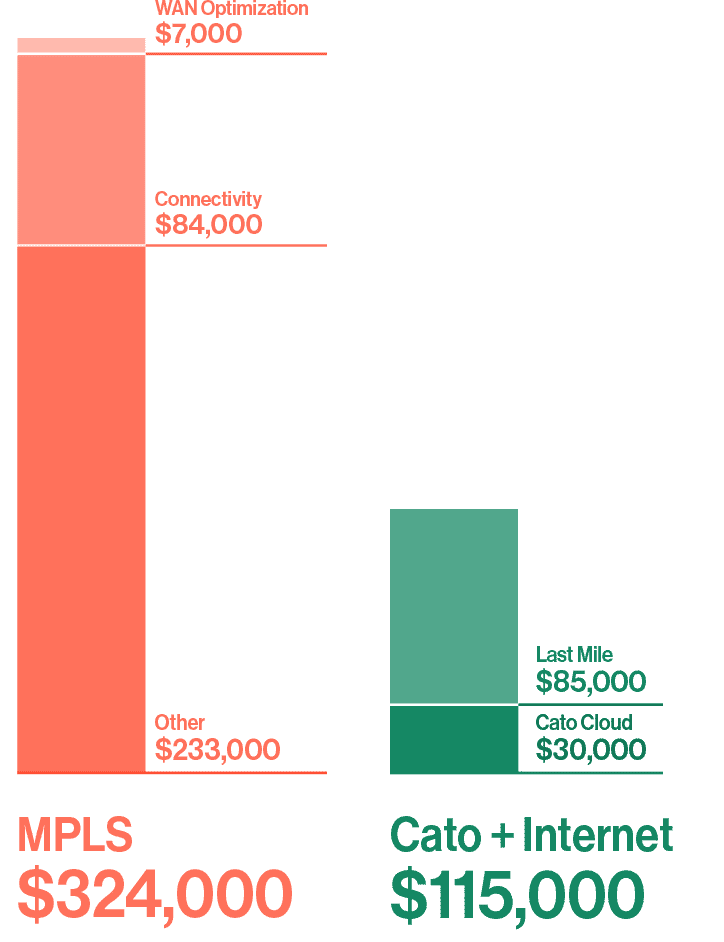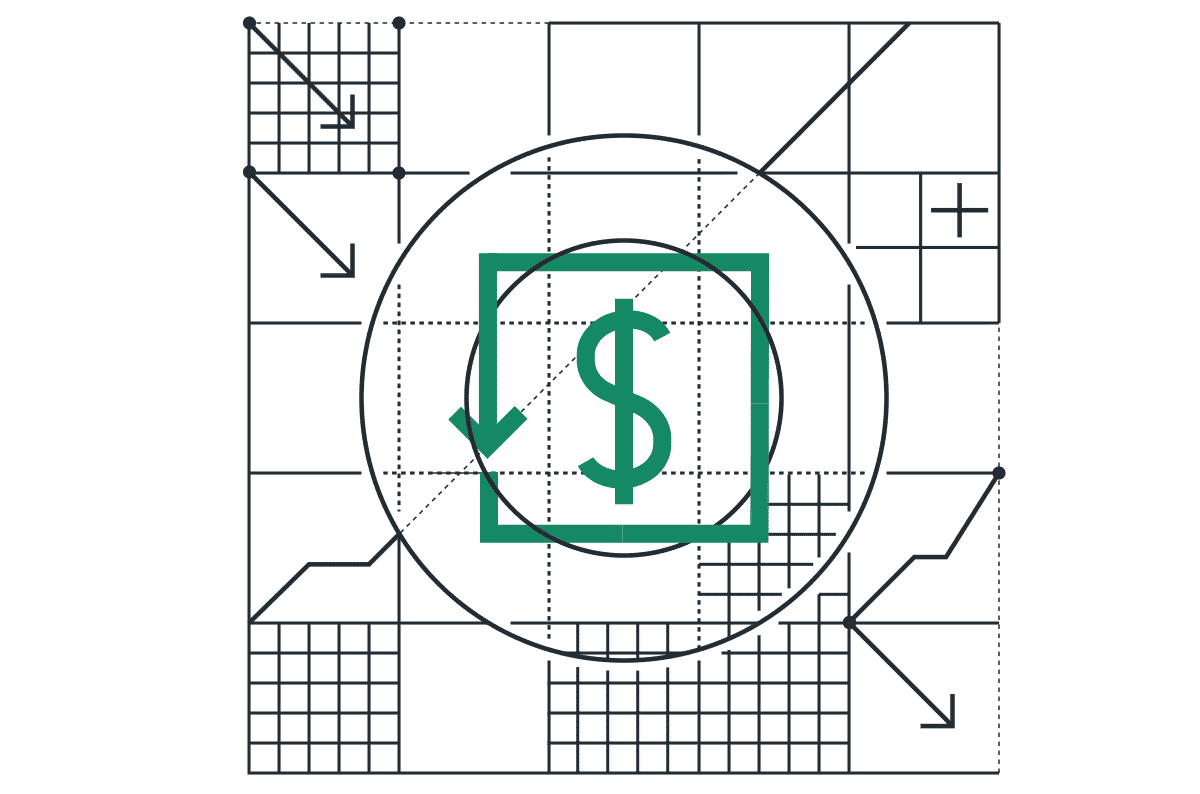|
Listen to post:
Getting your Trinity Audio player ready...
|
What is the ROI on SD-WAN projects? Most enterprises look at SD-WAN as an MPLS alternative, hoping to reduce their MPLS connectivity costs. But the actual SD-WAN ROI is a mix of hard and soft savings from increasing overall network capacity and availability to a reduced operational load of managing and securing the network. Let‘s look at the various areas of savings SD-WAN can offer and the resulting ROI.
SD-WAN ROI Driver #1: Reducing MPLS Connectivity Costs
Enterprises have long invested in managed MPLS services to connect locations. The bandwidth is expensive (relative to Internet capacity) and often limited or unavailable on some routes, forcing companies to either pay exorbitant fees to connect locations or, more likely, resort to Internet-based VPNs, complicating network design.
SD-WAN promises to break that paradigm, replacing MPLS entirely or partly with affordable last-mile Internet connectivity. The magnitude of SD-WAN savings is often related to how much MPLS can be replaced and the type of Internet-based connectivity.
Here there’s a balance of considerations. Symmetrical Internet connections (also known as Dedicated Internet Access or DIA) offer guaranteed capacity, providing small savings relative to MPLS. Asymmetrical connections with best-effort capacity, such as xDSL or cable, can be aggregated together to match and exceed MPLS last mile uptime at a substantial discount compared to MPLS.
5 Things SASE Covers that SD-WAN Doesn’t | EBOOKOften, the ROI argument for SD-WAN is less about hard cost savings and more about optimizing network spending. Enterprises receive far more capacity and functionality for the same amount spent on MPLS. The cost per bit drops dramatically, enabling IT to equip locations with 5x to 10x more capacity. With SD-WAN able to aggregate and failover between multiple last-mile lines, uptime increases significantly
One example was Fischer & Co, an automotive company that reduced its connectivity costs by 70% by replacing MPLS with Internet last-mile and Cato SASE Cloud while relying on Cato SSE 360 for network security protection. Along with the cost savings, Fischer & Co gained the agility to respond to new business challenges instantly, adding new security services or opening new locations, all without the operational overhead of upgrading and scaling of branch security appliances.

SD-WAN ROI Driver #2: Reducing the Costs of Branch Security
SD-WAN also allows organizations to avoid the branch security costs of legacy networks. With legacy architectures, enterprises backhaul branch Internet traffic to a regional datacenter for security inspection and policy enforcement. This approach consumed precious MPLS capacity, increasing costs while adding latency that undermined the user experience. With SD-WAN, companies avoid consuming expensive MPLS capacity on Internet traffic. Instead, MPLS only carries critical application traffic, offloading bandwidth hungry and less critical applications to Internet connections.
However, this now requires branch security to inspect and enforce policies on the Internet flows. SD-WAN appliances include basic firewalls, but those firewalls lack the threat protection needed by today’s enterprises. Branch firewalls offer more capabilities, but their capacity constraints limit inspection capabilities for CPU-intensive operations, such as SSL decryption, anti-malware, and IPS. As traffic grows or new capabilities are enabled, companies are often forced to upgrade their appliances. Cloud-based SSE solutions are more scalable but incur the operational cost of integrating and managing another point solution.
Network and network security convergence through a single-vendor SASE platform offers a way to tackle this tradeoff. Alewijnse, a Dutch manufacturing company, eliminated its MPLS network and applied enterprise-grade security to all traffic by switching to the Cato SASE Cloud, taking advantage of Cato’s full SSE 360 protection. “With Cato, we got the functionality of SD-WAN, a global backbone, and security service for our sites and mobile users, integrated together and at a fraction of the cost,” said Willem-Jan Herckenrath, ICT Manager at Alewijnse.
UMHS, a healthcare company, eliminated its MPLS network and branch security firewalls by moving to Cato’s converged, cloud-native and global SASE service. “UMHS is so satisfied with the decision to switch its firewalls to Cato that it plans to migrate all locations using MPLS as soon as their contracts expire. A cost analysis done by the organization shows that this change will save thousands of dollars by having all of its 13 locations connected to the Cato Cloud,” said Leslie W. Cothren, IT director at UMHS.
SD-WAN ROI Driver #3: Network Automation and Co-managed Services
One of the costliest components of enterprise networking is the network management model. Legacy network management comes in two flavors: Do It Yourself (DIY) and a managed service. With DIY, network managers often use crude tools like Command Line Interfaces (CLIs) to manage router configurations. Since any network outage costs the business, networking teams focus on availability, evolving the network very slowly. Maintaining dynamic traffic routing or failover becomes very complex. To reduce this complexity, IT outsources network management to service providers, increasing costs and longer resolution times depending on the provider.
SD-WAN promises an improvement in network agility. DIY enterprises can automate network changes and increase network resiliency. However, SD-WAN does add “one more box to manage.” For enterprises that prefer a managed service, a new co-managed model enables IT to make quick network changes through a self-service model while the service provider maintains the SD-WAN service. In a co-managed model, the customer doesn’t have to maintain the underlying infrastructure and can focus instead on business-specific outcomes.
A case in point is Sun Rich, a food supplier with a North American network comprised of multiple MPLS providers, SD-WAN appliances, WAN optimization solutions, and network security devices – all managed by a small IT team. Every appliance came with its management platform, complicating troubleshooting. By switching to the Cato SASE Cloud, Sun Rich reduced costs and gained control over network and security changes through Cato’s single, converged management application. “Based on our size, our annual renewals on our appliances alone were nearly Cato’s price,” says Adam Laing, Systems Administrator at Sun Rich. “Simplification also translates into better uptime. You can troubleshoot faster with one provider than five providers,” he says.
But Is SD-WAN Enough? Comparing SD-WAN to SASE
SD-WAN offers significant opportunities to reduce costs and gain more “bang for the buck” compared to MPLS, but SD-WAN alone will be insufficient to address the needs of today’s workforce. As such, an SD-WAN ROI evaluation must consider the myriad of additional point solutions needed to meet enterprise networking and security requirements.
The most obvious example, perhaps, is the hybrid workforce. SD-WAN only connects locations. Remote users will require additional services. Security requirements demand protection against malware, ransomware, and other network-based threats not provided by the rudimentary firewalls included in SD-WAN devices, forcing the deployment of third-party security solutions. Cloud-connectivity solutions are also required. Additionally, SD-WAN performance over the long haul is undermined by the unpredictability of the Internet core, requiring the subscription and integration of yet another solution – a global private backbone.
Separately, these individual solutions may be manageable, but together they significantly complicate troubleshooting and deployment. Deployment takes longer as each point solution must be deployed. Problems take longer to resolve as operations teams must jump between management interfaces to solve issues. In short, organizational agility is reduced at a time when agility is often the very reason for adopting SD-WAN.
How Does SASE Solve SD-WAN’s Limitations: Read the eBook
SASE solves these challenges while reducing overall spending compared to MPLS alternatives, like SD-WAN. Cato SASE Cloud overcomes SD-WAN’s limitations with built-in SSE 360, zero trust, cloud-native architecture with a complete range of security protections, including Secure Web Gateway (SWG), Cloud Access Security Broker (CASB), Data Loss Prevention (DLP), Zero Trust Network Access (ZTNA), and Firewall as a Service (FWaaS) with Advanced Threat Prevention (IPS and Next Generation Anti-Malware). Those capabilities operate from Cato’s global platform, making them available anywhere while providing location and remote users with MPLS-like performance at a fraction of global MPLS costs. And with all components managed through a single interface, troubleshooting happens far faster than when juggling multiple interfaces. In short, SASE provides the promises of SD-WAN without its limitations, delivering considerable cost savings without comprising security, simplicity, or performance. For a more in-depth comparison of SASE vs SD-WAN, download our complimentary eBook, 5 Things That SASE covers that SD-WAN Does Not.










